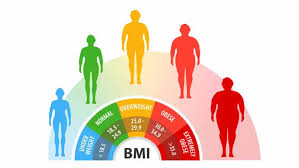The traditional body-mass index (BMI) cut-off point for obesity, recognized internationally, may not accurately reflect the health risks in middle-aged and older adults, according to research presented at this year’s European Congress on Obesity (ECO).
A study conducted by researchers from the University of Rome “Tor Vergata,” the University of Modena and Reggio Emilia in Italy, and the Beirut Arab University in Lebanon challenges the widely accepted BMI threshold of 30 kg/m², suggesting a lower cut-off point of 27 kg/m² may be more appropriate for adults aged 40 to 80 years.
Obesity, a chronic disease characterized by excessive fat deposits, has traditionally been identified using BMI, calculated by dividing weight in kilograms by the square of height in meters. However, the study highlights the inadequacy of this method, especially in older adults, whose body composition undergoes significant changes with age.
The research, which involved 4,800 adults aged 40 to 80 years, revealed that a substantial number of participants categorized as having a healthy BMI were, in fact, classified as obese when body fat percentage was considered. Specifically, around two-thirds of men and women were identified as obese based on body fat percentage, compared to around 38% using the WHO BMI criteria.
“Our real-world study in a clinical setting in Italy shows that the optimal BMI cut-off point (27 kg/m²) for adults aged over 40 is significantly lower than the widely used one-size-fits-all threshold (30 kg/m²),” stated Marwan El Ghoch, Professor from the University of Modena and Reggio Emilia, Italy, and lead author of the study. “This new BMI cut off recognizes the physiological differences between middle-aged and older adults and younger populations.”
Professor Antonino De Lorenzo from the University of Rome “Tor Vergata” emphasized the potential health implications of adhering to outdated BMI standards. “If we continue to use the WHO standard for obesity screening, we will miss many middle-aged and older adults who are at risk for obesity-related diseases including type 2 diabetes, heart disease, and some cancers,” he warned.
The study’s findings underscore the necessity of adopting lower BMI thresholds for identifying obesity in older adults to ensure accurate risk assessment and timely intervention. However, the authors acknowledge the limitations of their research, including its single-center nature and the absence of accounting for confounding factors like dietary habits and physical activity patterns.
Further large-scale studies across multiple sites and populations are warranted to validate these findings and inform future obesity guidelines effectively.
As the world grapples with the growing burden of obesity-related health issues, the recognition of age-specific BMI thresholds could prove pivotal in addressing the unique health needs of middle-aged and older adults, potentially mitigating the adverse health outcomes associated with obesity.
The study was presented at the European Congress on Obesity held in Venice, Italy, from May 12th to May 15th, 2024.












